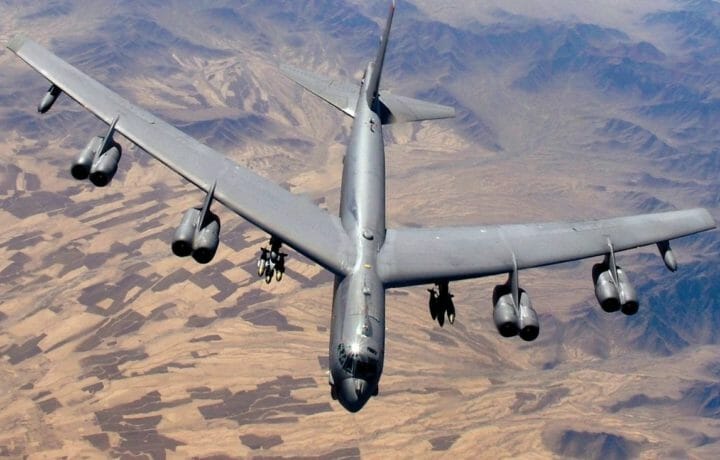U.S. Airforce B-52 Stratofortress bombers are flying into Afghanistan from al-Udeid airbase in Qatar, hitting targets around Kandahar, Herat, and Lashkar Gah in Helmand province, according to news outlets on Monday. The B-52 has been in service with the USAF since 1955 with approximately 58 still in service. Ironically, the bombers played a key role in toppling the Taliban in 2001.
In addition to the B-52s, AC-130 Spectre gunship and Reaper drones are flying at least five missions each day according to The Times, a British daily national newspaper based in London. The USS Ronald Reagan, a nuclear-powered aircraft carrier in the Arabian Sea, is contributing its F/A-18 Super Hornet fighter jets to the missions. Currently, they are not reported to be involved in the bombing.
As the Taliban try to make territorial gains throughout Afghanistan since President Biden’s U.S. forces departure order, airpower is rolling in. The move comes amid an increasingly dire situation created by the Afghanistan insurgents since initiation of their military campaign in May. According to Pentagon estimates, the Taliban now control half of Afghanistan’s 419 district centers.
Friday, the Taliban seized the southwest provincial city of Zaranj near the Iran border, making it the first provincial capital to be captured. Simultaneously, insurgents in the Afghan capital of Kabul, assassinated the government’s chief media officer. The U.S. Embassy on Saturday urged American citizens to leave Afghanistan immediately.
Afghan Government
On the August 2, Afghan President Ashraf Ghani blamed U.S. troop pullout for worsening violence amid Taliban gains. Ghulam Isaczai, permanent Afghan government representative at the UN, stated on 6 August at Security Council that the situation “has rapidly deteriorated due to increased violence by the Taliban and their brutal military offensive on major cities and population centers in several provinces”.
The Afghan government estimates that over 40,000 families have been displaced by the fighting since early May. “It is getting worse day by day here,” according to security analyst and retired colonel Mohammad Hassan told Arab News. “The cancelation of flights to Herat and the fact that America has back started using B-52 are not good signs. It will cause more panic among people at large and shows the precariousness of the situation.”
Unfortunately, the bombings demonstrate reliance on the U.S. for military equipment and support by Afghan forces. The Times reported over the weekend that Afghan air force is still dependent on U.S. supplied aircraft, which are running low on spares and trained technicians after the departure of U.S. contractors. Further confounding the problem is the shortage of exhausted pilots; with seven pilots recently killed from Taliban targeting.
Pakistan
Tension between Kabul and Islamabad continue to intensify. As reported in June, Afghanistan asked Pakistan to take “practical steps” to close Pakistani Taliban bases and end Taliban support. Last week, Afghan President Ghani claimed that “over 10,000 jihadi fighters from Pakistan and other places in the last month” had entered Afghanistan to aid the Taliban offensive. Ghani alleges Pakistan had failed to get the Taliban to “negotiate seriously” for a peaceful resolution in Afghanistan.
With Pakistan seemingly playing both sides, the U.S may be leveraging the current situation for continued use of Pakistani airspace for launching airstrikes and Afghan government support. An air corridor, linking Qatar with Kabul will probably remain open even after the withdrawal of the Coalition forces from Afghanistan.
The U.S. Position
Many believe the bomber deployment underscores the U.S. military’s commitment to regional security and demonstrates a unique ability to rapidly deploy on short notice. The bombings and airstrikes are part of the current effort to contain Taliban movement. With this understanding, defense sources insist there is an “intention to continue with the airstrikes after August 31, the date set for the withdrawal of the last remaining US troops in Afghanistan”.
However, even with any success associated with the bombings on Friday, the Taliban continue to fight in northern Afghanistan and take their fight from the countryside into the cities. Sunday, three more provincial capitals in the north (Kunduz, Sar-e-Pul and Taloqan) were hit by the insurgents, security sources confirmed.




